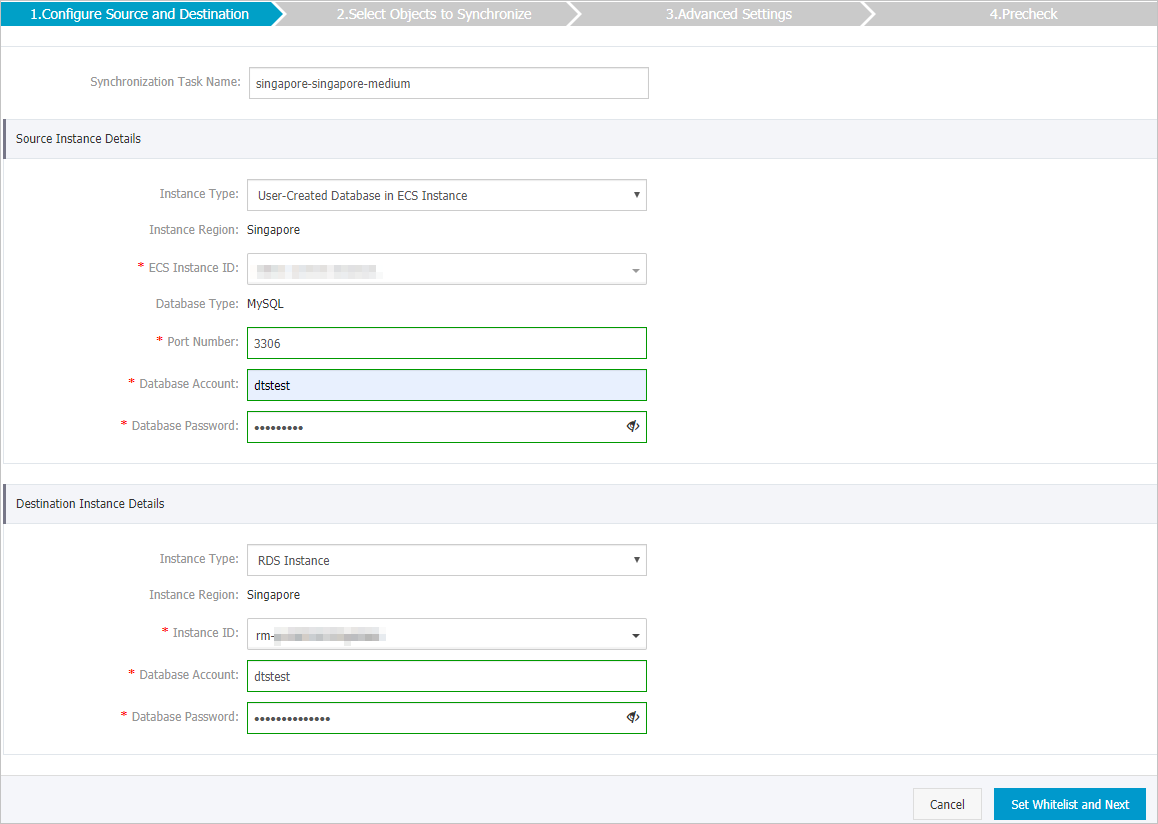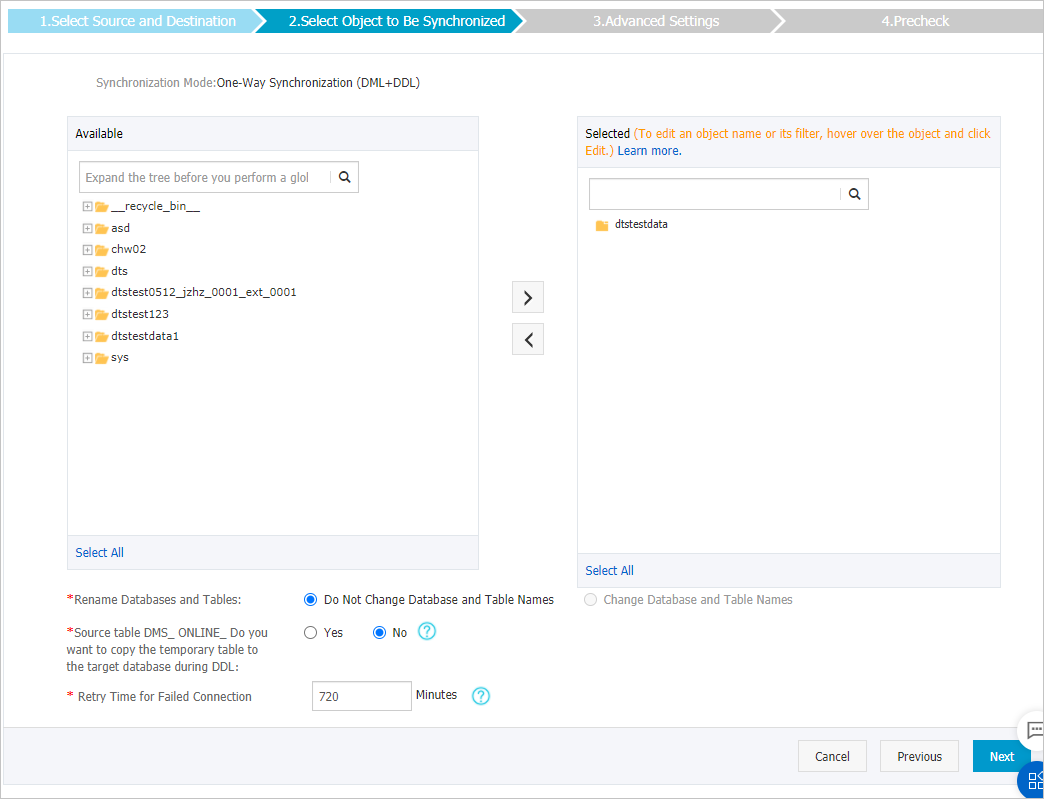You can use Data Transmission Service (DTS) to synchronize incremental data from a self-managed MySQL database hosted on Elastic Compute Service (ECS) to an RDS MySQL instance in real time.
Prerequisites
The engine version of the self-managed MySQL database is 5.1, 5.5, 5.6, 5.7, or 8.0.
An ApsaraDB RDS for MySQL instance is created. For more information, see Create an ApsaraDB RDS for MySQL instance..
Precautions
DTS uses read and write resources of the source and destination RDS instances during initial full data synchronization. This may increase the loads of the RDS instances. If the instance performance is unfavorable, the specification is low, or the data volume is large, database services may become unavailable. For example, DTS occupies a large amount of read and write resources in the following cases: a large number of slow SQL queries are performed on the source RDS instance, the tables have no primary keys, or a deadlock occurs in the destination RDS instance. Before data synchronization, evaluate the impact of data synchronization on the performance of the source and destination RDS instances. We recommend that you synchronize data during off-peak hours. For example, you can synchronize data when the CPU utilization of the source and destination RDS instances is less than 30%.
We recommend that you do not use gh-ost or pt-online-schema-change to perform DDL operations on objects during data synchronization. Otherwise, data synchronization may fail.
If you use only DTS to write data to the destination database, you can use Data Management (DMS) to perform online DDL operations during data synchronization. For more information, see Perform lock-free DDL operations.
The tables to be migrated in the source database must have PRIMARY KEY or UNIQUE constraints and all fields must be unique. Otherwise, the destination database may contain duplicate data records.
During initial full data synchronization, concurrent INSERT operations cause fragmentation in the tables of the destination instance. After initial full data synchronization, the tablespace of the destination cluster is larger than that of the source database.
If the destination database is an ApsaraDB RDS for MySQL instance that does not run MySQL 5.7 or 8.0, DTS creates the dtssyncwriter database account that has write permissions and is exclusive to DTS for the destination database.
Billing
| Synchronization type | Task configuration fee |
| Schema synchronization and full data synchronization | Free of charge. |
| Incremental data synchronization | Charged. For more information, see Billing overview. |
Supported synchronization topologies
One-way one-to-one synchronization
One-way one-to-many synchronization
One-way many-to-one synchronization
One-way cascade synchronization
Two-way one-to-one synchronization
NoteFor more information about two-way synchronization, see Configure two-way synchronization between MySQL databases.
SQL operations that can be synchronized
Operation type | SQL statement |
DML | INSERT, UPDATE, DELETE, and REPLACE |
DDL |
|
Limits
Incompatibility with triggers
If you select a database as the object to synchronize and the database contains a trigger that updates a table, data inconsistency may occur. For more information about how to resolve this issue, see Configure a data synchronization task for a source database that contains a trigger.
Limits on RENAME TABLE operations
RENAME TABLE operations may cause data inconsistency between the source and destination databases. For example, if only Table A is selected as the object to synchronize and is renamed Table B, Table B cannot be synchronized to the destination database. To prevent this situation, you can select the entire database in which Table A is located as the object to synchronize when you configure the data synchronization task.
Preparations
Before you configure the data synchronization task, you must create a database account and configure binary logging. For more information, see Create an account for a self-managed MySQL database and configure binary logging.
Procedure
Purchase a data synchronization instance. For more information, see Purchase a DTS instance.
NoteSelect MySQL for both the source instance and the destination instance. Select One-way Synchronization as the synchronization topology.
Log on to the DTS console.
NoteIf you are navigated to the DMS console from the DTS console, you can move the pointer over the
 icon in the lower-right corner and click the
icon in the lower-right corner and click the  icon to return to the DTS console.
icon to return to the DTS console. If the new version of the DTS console appears after the logon, you can click the
 icon in the lower-right corner to return to the previous version.
icon in the lower-right corner to return to the previous version.
In the left-side navigation pane, click Data Synchronization.
In the upper part of the Data Synchronization Tasks page, select the region in which the destination instance resides.
Find the data synchronization instance and click Configure Task in the Actions column.

Configure the source and destination instances.

Section
Parameter
Description
N/A
Synchronization Task Name
The task name that DTS automatically generates. We recommend that you specify a descriptive name that makes it easy to identify the task. You do not need to use a unique task name.
Source Instance Details
Instance Type
Select User-Created Database in ECS Instance.
Instance Region
The source region that you selected on the buy page. The value of this parameter cannot be changed.
ECS Instance ID
The ID of the ECS instance that hosts the source MySQL database.
Database Type
The value of this parameter is set to MySQL and cannot be changed.
Port Number
The service port number of the self-managed MySQL database. Default value: 3306.
Database Account
The account of the self-managed MySQL database. The account must have the SELECT permission on the required objects and the REPLICATION CLIENT, REPLICATION SLAVE, and SHOW VIEW permissions.
Database Password
The password for the account of the self-managed MySQL database.
Destination Instance Details
Instance Type
Select RDS Instance.
Instance Region
The destination region that you selected on the buy page. The value of this parameter cannot be changed.
Instance ID
The ID of the destination ApsaraDB RDS instance.
Database Account
The database account of the destination ApsaraDB RDS instance.
NoteIf the database engine of the destination ApsaraDB RDS instance is MySQL 5.5 or MySQL 5.6, you do not need to configure the Database Account or Database Password parameter.
Database Password
The password of the database account.
Encryption
Select Non-encrypted or SSL-encrypted. If you want to select SSL-encrypted, you must enable SSL encryption for the ApsaraDB RDS instance before you configure the data synchronization task. For more information, see Use a cloud certificate to enable SSL encryption.
ImportantThe Encryption parameter is available only within regions in the Chinese mainland and the China (Hong Kong) region.
In the lower-right corner of the page, click Set Whitelist and Next.
Select the synchronization policy and the objects to be synchronized.

Parameter/Section
Description
Select Object to Be Synchronized
Select one or more objects from the Available section and click the
 icon to move the objects to the Selected section.
icon to move the objects to the Selected section. You can select tables or databases as the objects to be synchronized.
NoteIf you select a database as the object to synchronize, all schema changes in the database are synchronized to the destination database.
By default, after an object is synchronized to the destination database, the name of the object remains unchanged. You can use the object name mapping feature to rename the objects that are synchronized to the destination database. For more information, see Rename an object to be synchronized.
Rename Databases and Tables
You can use the object name mapping feature to rename the objects that are synchronized to the destination instance. For more information, see Object name mapping.
Source table DMS_ONLINE_Do you want to copy the temporary table to the target database during DDL
If you use DMS to perform online DDL operations on the source database, you can specify whether to synchronize temporary tables generated by online DDL operations.
Yes: DTS synchronizes the data of temporary tables generated by online DDL operations.
NoteIf online DDL operations generate a large amount of data, the data synchronization task may be delayed.
No: DTS does not synchronize the data of temporary tables generated by online DDL operations. Only the original DDL data of the source database is synchronized.
NoteIf you select No, the tables in the destination database may be locked.
Retry Time for Failed Connection
By default, if DTS fails to connect to the source or destination database, DTS retries within the next 720 minutes (12 hours). You can specify the retry time based on your needs. If DTS reconnects to the source and destination databases within the specified time, DTS resumes the data synchronization task. Otherwise, the data synchronization task fails.
NoteWhen DTS retries a connection, you are charged for the DTS instance. We recommend that you specify the retry time based on your business needs. You can also release the DTS instance at your earliest opportunity after the source and destination instances are released.
In the lower-right corner of the page, click Next.
Select the initial synchronization types.

During initial synchronization, DTS synchronizes the schema and data of required objects from the source instance to the destination instance. The schema and data are the basis for subsequent incremental synchronization.
Initial synchronization includes initial schema synchronization and initial full data synchronization. In most cases, you must select both Initial Schema Synchronization and Initial Full Data Synchronization.
In the lower-right corner of the page, click Precheck.
ImportantBefore you can start the data synchronization task, a precheck is performed. You can start the data synchronization task only after the task passes the precheck.
If the task fails to pass the precheck, you can click the
 icon next to each failed item to view details.
icon next to each failed item to view details. After you troubleshoot the issues based on the causes, you can run a precheck again.
If you do not need to troubleshoot the issues, you can ignore failed items and run a precheck again.
Close the Precheck dialog box after the The precheck is passed. message is displayed in the Precheck dialog box. Then, the data synchronization task starts.
Wait until initial synchronization is complete and the data synchronization task enters the Synchronizing state.
You can view the state of the data synchronization task on the Synchronization Tasks page.
